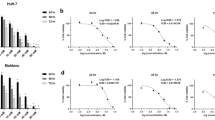Abstract
The present study was aimed to explore the effect of triazole on growth and viability of liver cancer cells. Cell growth was examined using the MTT test and expression of several proteins was assessed by western blotting assay. The Matrigel-coated Transwell assay was employed to examine the infiltration of cells. The data from MTT assay showed that MHCC97H and H4TG liver cancer cell viability was inhibited by triazole in a concentration-dependent manner. After treatment with 0.5, 1.0, 2.0, 4, 8, and 16 µM doses of triazole, the rate of H4TG cell viability was decreased to 96, 73, 58, 39, 29, and 28%, respectively. Treatment of MHCC97H cells with 0.5, 1.0, 2.0, 4, 8, and 16 µM doses of triazole resulted in a reduction in cell viability to 94, 70, 53, 35, 22, and 21%, respectively. Triazole treatment also led to a significant reduction in MHCC97H cell invasiveness compared to the control cells. In MHCC97H cells treated with triazole, there was a noticeable decrease in the levels of p-ERK1/2, and p-Akt protein expression. Treatment of MHCC97H cells with triazole resulted in a prominent increase in p-p38 level. In summary, triazole inhibits growth and viability of liver cancer cells through targeting the activation of p-ERK1/2 and Akt proteins. Therefore, triazole may be investigated further as a therapeutic agent for the treatment of liver cancer.





Similar content being viewed by others
REFERENCES
Tomuleasa, C., Soritau, O., Fischer-Fodor, E., Pop, T., Susman, S., Mosteanu, O., Petrushev, B., Aldea, M., Acalovschi, M., Irimie, A., and Kacso, G., Gastrointest. Liver Dis., 2010, vol. 19, no. 2, pp. 61–67. https://doi.org/10.5144/1658-3876.2011.60
Ma, S., Chan, K.W., and Guan, X., Stem Cell Rev., 2008, vol. 4, no. 3, pp. 179–192. https://doi.org/10.1007/s12015-008-9035-z
Ricci-Vitiani, L., Lombardi, D.G., Pilozzi, E., Bif-foni, M., Todaro, M., Peschle, C., and De Maria, R., Nature, 2007, vol. 445, no. 7123, pp. 111–115. https://doi.org/10.1038/nature05384
Lee, T.K.W., Castilho, A., Ma, S., and Ng, I.O., Liver Int., 2009, vol. 29, no. 7, pp. 955–965. https://doi.org/10.1111/j.1478-3231.2009.02040.x
Yang, J., Liu, X., Bhalla, K., Kim, C.N., Ibrado, A.M., Cai, J., Peng, N.I., Jones, D.P., and Wang, X., Science, 1997, vol. 275, no. 5303, pp. 1129–1132. https://doi.org/10.1126/science.275.5303.1129
Lee, D., Ha, J., Kim, Yu., Jang, M., Park, S.J., Yoon, H.S., Kim, E., Bae, K., Park, B.C., Park, S.G., Yi, G., and Chi, S., Molecules Cells, 2014, vol. 37, no. 3, pp. 264–269. https://doi.org/10.14348/molcells.2014.0001
Oltval, Z.N., Milliman, C.L., and Korsmeyer, S.J., Cell, 1993, vol. 74, no. 4, pp. 609–619. https://doi.org/10.1016/0092-8674(93)90509-o
Kessenbrock, K., Plaks, V., and Werb, Z., Cell, 2010, vol. 141, no. 1, pp. 52–67. https://doi.org/10.1016/j.cell.2010.03.015
Choi, Yo.D., Cho, N.H., Ahn, H.S., Cho, K.S., Cho, S.Yo., and Yang, W.J., J. Urology, 2007, vol. 177, no. 3, pp. 1174–1178. https://doi.org/10.1016/j.juro.2006.10.031
Di Carlo, A., Terracciano, D., Mariano, A., and Macchia, V., Oncol. Rep., 2006, vol. 15, pp. 1321–1326. https://doi.org/10.3892/or.15.5.1321
Kanayama, H., Yokota, K., Kurokawa, Y., Murakami, Y., Nishitani, M., and Kagawa, S., Cancer, 1998, vol. 82, no. 7, pp. 1359–1366. https://doi.org/10.1002/(sici)1097-0142(19980401)82:7<1359::aid-cncr20>3.3.co;2-f
Davies, B., Waxman, J., Wasan, H., Abel, P., Williams, G., Krausz, T., Neal, D., Thomas, D., Hanby, A., and Balkwill, F., Cancer Res., 1993, vol. 53, pp. 5365–5369.
Kung, C., Budina, A., Balaburski, G., Bergenstock, M.K., and Murphy, M., Crit. Rev. Eukaryotic Gene Expression, 2011, vol. 21, no. 1, pp. 71–100. https://doi.org/10.1615/critreveukargeneexpr.v21.i1.50
Thorburn, A., Apoptosis, 2008, vol. 13, no. 1, pp. 1–9. https://doi.org/10.1007/s10495-007-0154-9
Yamamoto, M., Suzuki, S.O., and Himeno, M., Oncol. Lett., 2010, vol. 1, no. 3, pp. 489–493. https://doi.org/10.3892/ol_00000086
Shinojima, N., Yokoyama, T., Kondo, Ya., and Kondo, S., Autophagy, 2007, vol. 3, no. 6, pp. 635–637. https://doi.org/10.4161/auto.4916
Zhang, D., Liu, J., Deng, L., Chen, M., Yiu, A., Cao, H., Tian, H., Fung, K., Kurihara, H., Pan, J., and Ye, W., Carcinogenesis, 2013, vol. 34, no. 6, pp. 1331–1342. https://doi.org/10.1093/carcin/bgt060
Li, H., Jin, X., Zhang, Z., Xing, Yu., and Kong, X., Cell Biochem. Funct., 2013, vol. 31, no. 5, pp. 427–433. https://doi.org/10.1002/cbf.2917
Tewari, K.S. and Monk, B.J., Curr. Oncol. Rep., 2005, vol. 7, no. 6, pp. 419–434. https://doi.org/10.1007/s11912-005-0007-z
Zhou, H., Zhang, J., Li, A., Wang, Z., and Lou, X.E., Cancer Chemother. Pharmacol., 2010, vol. 66, no. 1, pp. 21–29. https://doi.org/10.1007/s00280-009-1129-z
Hirte, H., Kennedy, E.B., Elit, L., and Fung Kee Fung, M., Curr. Oncol., 2015, vol. 22, no. 3, pp. 211–219. https://doi.org/10.3747/co.22.2447
Brzezianska, E. and Pastuszak-Lewandoska, D., Front. Biosci. (Landmark Ed.), 2011, vol. 16, no. 1, pp. 422–439. https://doi.org/10.2741/3696
Friday, B.B. and Adjei, A.A., Clin. Cancer Res., 2008, vol. 14, no. 2, pp. 342–346. https://doi.org/10.1158/1078-0432.ccr-07-4790
Mccubrey, J.A., Steelman, L.S., and Chappell, W.H., Oncotarget, 2012, vol. 3, pp. 1068–1111.
Wu, Y.Т., Tan, H.L., Huang, Q., Ong, C.N., and Shen, H.M., Autophagy, 2009, vol. 5, no. 6, pp. 824–834. https://doi.org/10.4161/auto.9099
Wei, Y., Sinha, S., and Levine, B., Autophagy, 2008, vol. 4, no. 7, pp. 949–951. https://doi.org/10.4161/auto.6788
Funding
This work was supported by ongoing institutional funding. No additional grants to carry out or direct this particular research were obtained.
Author information
Authors and Affiliations
Corresponding author
Ethics declarations
ETHICS APPROVAL AND CONSENT TO PARTICIPATE
This work does not contain any studies involving human and animal subjects. Data analysis was performed from the open-access database Pulse Transit Time PPG Dataset (version 1.1.0) [9]. According to the Pulse Transit Time PPG Dataset data, all studies were conducted in accordance with the principles of biomedical ethics set out in the 1964 Declaration of Helsinki and its subsequent amendments, and all participants provided written informed consent.
CONFLICT OF INTEREST
The authors of this work declare that they have no conflicts of interest.
Additional information
Publisher’s Note.
Pleiades Publishing remains neutral with regard to jurisdictional claims in published maps and institutional affiliations.
Rights and permissions
About this article
Cite this article
Shanfeng Li, Zhou, L., Zhao, F. et al. Inhibition of Liver Cancer Cell Viability by Triazole through Up-regulation of p38 Phosphorylation and Targeting the Activation of p-ERK1/2 and Akt Protein Expression. Dokl Biochem Biophys (2024). https://doi.org/10.1134/S1607672923600525
Received:
Revised:
Accepted:
Published:
DOI: https://doi.org/10.1134/S1607672923600525




